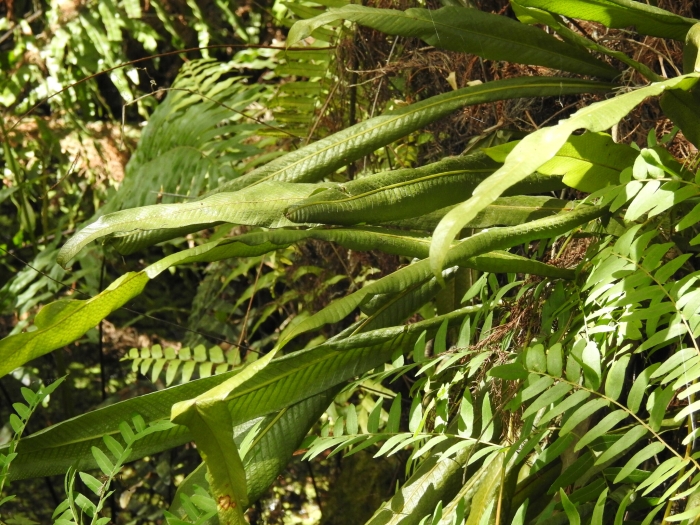Long Strap Fern
(Campyloneurum phyllitidis)
Long Strap Fern (Campyloneurum phyllitidis)
/
/

Rachel Stringham
CC BY 4.0
Image By:
Rachel Stringham
Recorded By:
Copyright:
CC BY 4.0
Copyright Notice:
Photo by: Rachel Stringham | License Type: CC BY 4.0 | License URL: http://creativecommons.org/licenses/by/4.0/ | Rights Holder: Rachel Stringham | Publisher: iNaturalist | Date Created: 2023-03-16T10:32:17-07:00 |
























Estimated Native Range
Summary
Campyloneurum phyllitidis, commonly known as Long Strap Fern, is an epiphytic fern native to tropical and subtropical regions, including the Caribbean, Mexico, Central and South America, and the southeastern United States, particularly Florida. It thrives in humid forest environments, often attaching to tree trunks and branches in the canopies of rainforests and occasionally on rocks in more xeric conditions. This fern typically exhibits a large rhizome with fine rootlets that are covered in reddish-brown scales.
The Long Strap Fern is characterized by its simple, hairless fronds that can reach lengths of 18-39 inches, creating an elegant and elongated appearance. The fronds are a deep green, contributing to the plant’s ornamental value, which was highly appreciated during the Victorian era. In cultivation, it is often used in hanging baskets, on tree trunks, or in shaded garden areas where its tropical aesthetic can be showcased. It prefers high humidity, consistent moisture without waterlogging, and well-draining soil or bark mix. While it can tolerate low light conditions, it thrives in bright, indirect light. It is relatively easy to maintain, making it a popular choice for indoor and outdoor gardening. However, it can be susceptible to scale insects and mealybugs, which should be monitored and managed as needed.CC BY-SA 4.0
The Long Strap Fern is characterized by its simple, hairless fronds that can reach lengths of 18-39 inches, creating an elegant and elongated appearance. The fronds are a deep green, contributing to the plant’s ornamental value, which was highly appreciated during the Victorian era. In cultivation, it is often used in hanging baskets, on tree trunks, or in shaded garden areas where its tropical aesthetic can be showcased. It prefers high humidity, consistent moisture without waterlogging, and well-draining soil or bark mix. While it can tolerate low light conditions, it thrives in bright, indirect light. It is relatively easy to maintain, making it a popular choice for indoor and outdoor gardening. However, it can be susceptible to scale insects and mealybugs, which should be monitored and managed as needed.CC BY-SA 4.0
Plant Description
- Plant Type: Fern
- Height: 2-3 feet
- Width: 2-3 feet
- Growth Rate: Moderate
- Flower Color: N/A
- Flowering Season: Non-Flowering
- Leaf Retention: Evergreen
Growth Requirements
- Sun: Part Shade, Full Shade
- Water: Medium
- Drainage: Medium, Fast
Common Uses
Border Plant, Low Maintenance, Potted Plant
Natural Habitat
Tropical and subtropical regions, including the Caribbean, Mexico, Central and South America, and the southeastern United States, particularly Florida, in humid forest environments and occasionally on rocks in xeric conditions
Other Names
Common Names: Long Strap Fern, Strap Fern, Cow-Tongue Fern, Ribbon Fern
Scientific Names: , Campyloneurum phyllitidis, Campyloneurum moritzianum, Campyloneurum sieberianum, Campyloneurum undulatum, Cyrtophlebium phyllitidis, Polypodium comosum, Polypodium gladiatum, Polypodium laevigatum var. rigidum, Polypodium levigatum var. rigidum
GBIF Accepted Name: